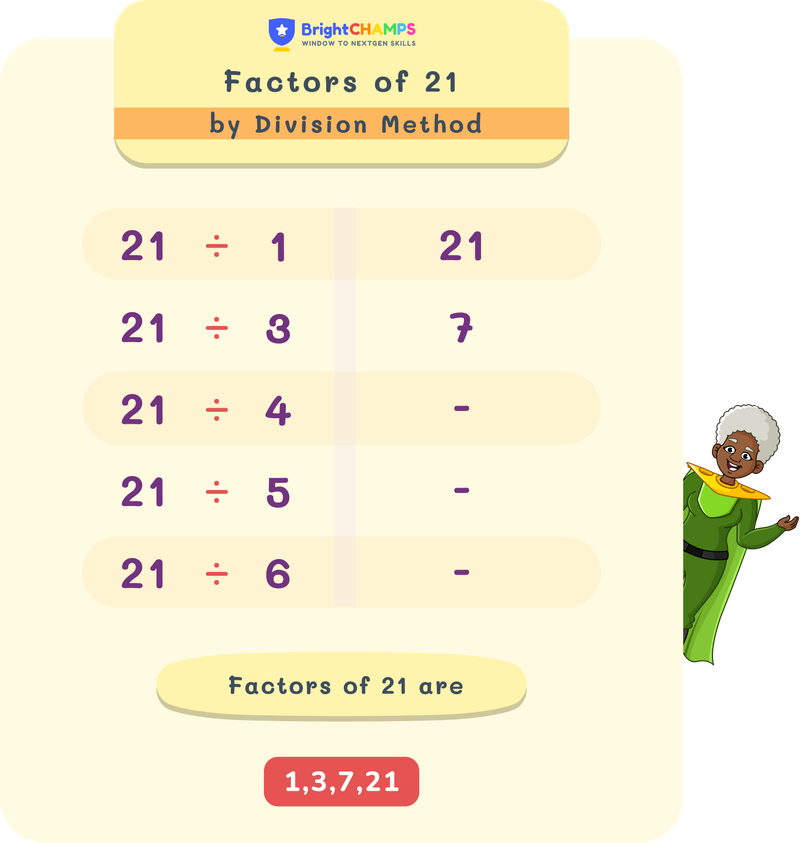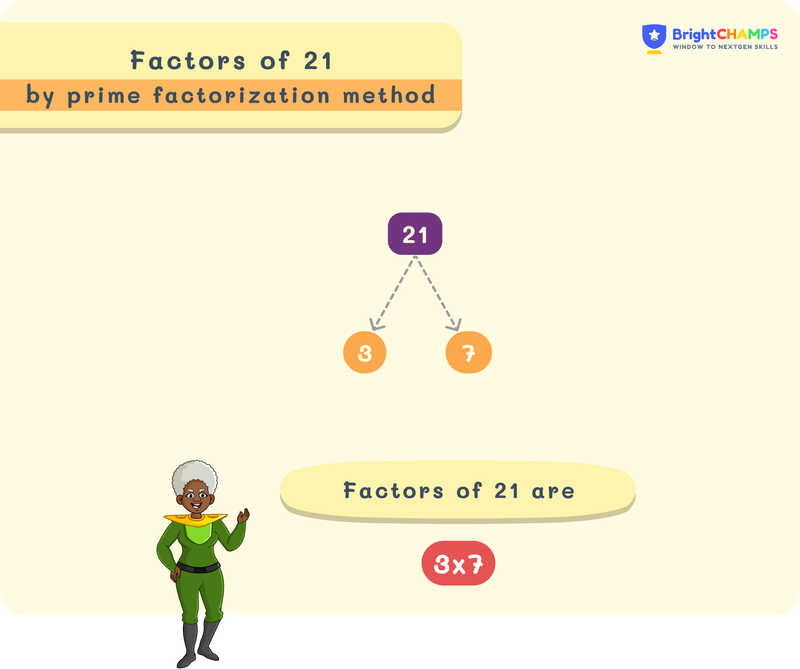Summarize this article:
 714 Learners
714 LearnersLast updated on December 17, 2025
Factors of 21

Numbers whose dividend is completely divisible by quotient are its factors. In real life, factors are helpful in scenarios like packing boxes and arranging seats. In this article, we will be studying examples, mistakes, and methods to solve factors of 21.

What are the Factors of 21
The factors of 21 are 1, 3, 7 and 21
Negative Factors- These are negative counterparts of the positive factors.
Negative factors: -1, -3, -7, -21
Prime Factors - Prime factors are the prime numbers themselves, when multiplied together, give 21 as the product.
Prime factor: 3, 7
Prime Factorization- Prime factorization involves breaking 21 into its prime factors
It is expressed as 31 × 71
The factors of 21 can be written as shown in the table given below:
| Factor | Type Values |
| Positive Factors of 21 | 1, 3, 7, 21 |
| Negative Factors of 21 | -1, -3, -7, -21 |
| Prime Factors of 21 | 3, 7 |
| Prime Factorization of 21 | 3 × 7 |
| The Sum of the Factors of 21 | 32 |

How to Find the Factors of 21
There are different methods to find the factors of 21.
Methods to find the factors of 21:
- Multiplication Method
- Division Method
- Prime Factor and Prime Factorization

Finding Factors Using Multiplication Method
The multiplication method finds the pair of factors that give 21 as their product.
Step-by-step process
Step 1: Find the pair of numbers whose product is 21.
Step 2: The factors are those numbers, when multiplied, give 21.
Step 3: Make a list of numbers whose product will be 21.
A list of numbers whose products are 21 is given below:
1 × 21 = 21
3 × 7 = 21

Explore Our Programs



Finding Factors Using Division Method
The division method finds the numbers that fully divide the given number.
Step-by-step process
Step 1: Since every number is divisible by 1, 1 will always be a factor. Example: 21÷1 = 21
Step 2: Move to the next integer. Both divisor and quotient are the factors.
Overview of Factors of 21 using the division method


Prime Factors and Prime Factorization

Prime Factors of 21
Prime Factors of 21-There is only one prime factor for 21
Prime factors of 21: 3, 7
Steps to find the prime factors of 21
Step 1: Divide 21 using the prime number 3
21÷3 = 7
Step 2: Divide 5 with the prime number 7
7÷7 = 1

Prime Factorization of 21
Prime Factorization of 21- Prime Factorization breaks down the prime factors of 21
Expressed as 31 × 71
Factor Tree
The prime factorization is visually represented using the factor tree. It helps to understand the process easily. In this factor tree, each branch splits into prime factors.
Factor Tree for 21:


Factor Pairs of 21
The factors of 21 can be written in both positive and negative pairs. The table below represents the factor pairs of 21, where the product of each pair of numbers is equal to 21.
Positive Pair Factors of 21:
| Factors | Positive Pair Factors |
| 1 × 21 = 21 | 1, 21 |
| 3 × 7 = 21 | 3, 7 |
Since the product of two negative numbers is also positive, 21 also has negative pair factors.
Negative Pair Factors of 21:
| Factors | Negative Pair Factors |
| −1 × −21 = 21 | −1, −21 |
| −3 × −7 = 21 | −3, −7 |

Common Mistakes and How to Avoid Them in Factors of 21
Mistakes can occur while finding the factors. Learn about the common errors that can occur. Solutions to solve the common mistakes are given below.

FAQs on Factors of 21

Problem 1
Can you express 21 as a product of two factors other than 1 and 21?

Yes, 21 can be expressed as a product of factors 3 and 7.
Explanation
When 3 is multiplied by 7 (3×7) we get 21 as the product. Other than the factors 1 and 21, we can also multiply 3 and 7 to get the product 21.

Problem 2
What is the sum of factors of 21?

The sum of factors of 21 is 32
Explanation
Write the factors of 21 and add them together to get the sum.
The factors of 21 are 1, 3, 7 and 21. Sum of factors = 1+3+7+21 = 32

Problem 3
Identify the factor pair whose sum is 10

The factor pair is (3,7)
Explanation
When the factor pair (3,7) is added (3 + 7), we get 10 as the sum.

Problem 4
At a Costco store in Chicago, a teacher buys 21 snack packs for a school event. She wants to arrange the packs equally into rows with no leftovers. What are all the possible numbers of packs she can place in each row?

1, 3, 7, 21
Explanation
To arrange the snack packs evenly, we find all the factors of 21. Factors are numbers that divide 21 exactly without leaving a remainder.
21 ÷ 1 = 21
21 ÷ 3 = 7
21 ÷ 7 = 3
21 ÷ 21 = 1
So, the factors of 21 are 1, 3, 7, and 21.

Problem 5
A youth NFL football camp in Dallas orders 21 jerseys for players. The coach wants to divide the jerseys equally among groups. Which group sizes are possible without any jersey left over?

1, 3, 7, 21
Explanation
To divide the jerseys equally, the group size must be a factor of 21.
Since 21 can be divided evenly by 1, 3, 7, and 21, these are the possible group sizes. Any other number would leave leftover jerseys.

Problem 6
A CVS pharmacy in Boston receives a shipment of 21 medicine sample packets for a school science health program. The packets must be divided equally among students. What are the possible numbers of students who can receive the packets evenly?

1, 3, 7, 21
Explanation
To distribute the medicine packets evenly, we list the factors of 21.
Only numbers that divide 21 completely are valid. These are 1, 3, 7, and 21.
So, the packets can be shared evenly among 1, 3, 7, or 21 students.


FAQs on Factors of 21
1.Does 21 only have 2 factors?
2.Is 21 a prime factor?
3.What is the factor tree of 21?
4.Is 18 a factor of 21?
5.Is 21 a factor of 28?
6.How many factors does 21 have?
7.What is the smallest factor of 21?
8.What is the largest factor of 21?
9.Which factors of 21 add up to 13?
10.How many even factors does 21 have?
11.What are the odd factors of 21?
12.What is the sum of all the factors of 21?


Hiralee Lalitkumar Makwana
About the Author
Hiralee Lalitkumar Makwana has almost two years of teaching experience. She is a number ninja as she loves numbers. Her interest in numbers can be seen in the way she cracks math puzzles and hidden patterns.
Fun Fact
: She loves to read number jokes and games.


















